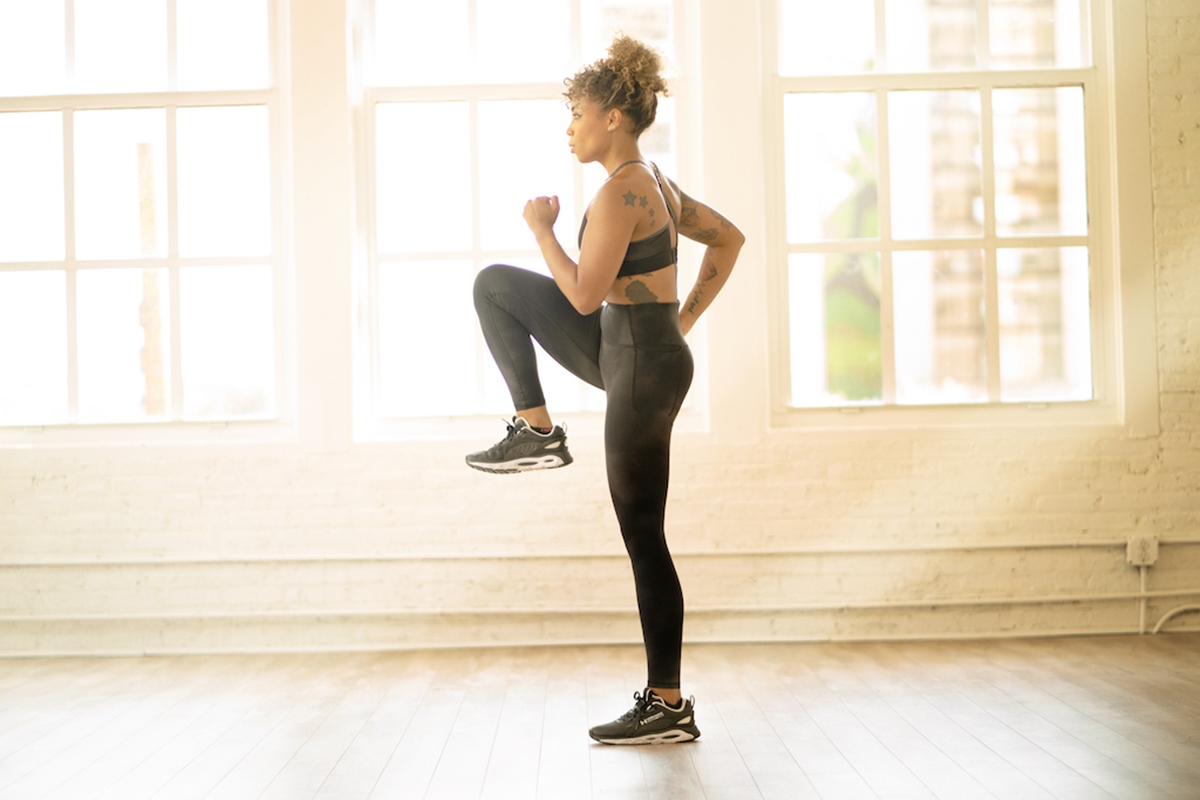Home>Misc>Featured>How To Start High Intensity Interval Training


Featured
How To Start High Intensity Interval Training
Modified: March 2, 2024
Learn how to start high intensity interval training with our featured guide, packed with helpful tips and workouts to maximize your fitness results.
Introduction
High Intensity Interval Training (HIIT) is a popular and effective exercise method that has been gaining traction in the fitness world. Unlike traditional cardio workouts that involve steady-state exercises, HIIT involves short bursts of intense exercise followed by brief recovery periods.
This style of training has become increasingly popular because of its efficiency and ability to deliver maximum results in a shorter amount of time. With HIIT, you can achieve significant improvements in cardiovascular fitness, burn calories, and build lean muscle mass.
In this article, we will explore the benefits of HIIT, how to prepare for a HIIT workout, and the basic structure of a HIIT session. We will also discuss how to select exercises, establish intensity and duration, and ensure proper form and technique. Additionally, we will cover the importance of rest and recovery and how to progress in your HIIT training journey.
Whether you are a fitness enthusiast looking to shake up your routine or a beginner looking to kickstart your fitness journey, HIIT can be an excellent choice. By incorporating HIIT into your workout regimen, you can maximize your fitness gains and achieve your goals in a time-efficient manner.
So, let’s dive into the world of high intensity interval training and discover how it can transform your workouts and elevate your fitness levels.
Benefits of High Intensity Interval Training (HIIT)
High intensity interval training (HIIT) offers a wide range of benefits that make it a highly effective exercise method for individuals of all fitness levels. Let’s explore some of the key advantages of incorporating HIIT into your fitness routine.
- Efficient calorie and fat burning: HIIT workouts are known for their ability to burn a significant amount of calories in a short period of time. The intense bursts of exercise followed by active recovery periods elevate your heart rate and increase your metabolism, resulting in improved calorie and fat burning even after your workout is over.
- Time saving: One of the biggest advantages of HIIT is its time efficiency. With HIIT, you can achieve the same or even better results compared to longer, steady-state cardio sessions in a fraction of the time. A typical HIIT workout can range from 10 to 30 minutes, making it a perfect option for individuals with busy schedules.
- Improved cardiovascular fitness: HIIT workouts challenge your cardiovascular system by pushing your heart rate to its maximum capacity during the intense intervals. Over time, this improves your cardiovascular fitness and increases your aerobic and anaerobic endurance.
- Muscle building and toning: HIIT workouts engage multiple muscle groups and promote muscle building and toning. The explosive movements and resistance exercises used in HIIT stimulate muscle growth and help you develop lean muscle mass, giving you a more defined and sculpted physique.
- Increased metabolism: HIIT has been shown to boost your metabolism and increase the amount of calories you burn even after your workout. This is known as the afterburn effect or excess post-exercise oxygen consumption (EPOC). The intense nature of HIIT elevates your metabolism, causing your body to continue burning calories at a higher rate for hours after your workout.
- Adaptable to various fitness levels: HIIT workouts can be customized to accommodate individuals of all fitness levels. Whether you are a beginner or a seasoned athlete, you can adjust the intensity, duration, and rest intervals to suit your fitness level and gradually increase the difficulty as you progress.
The benefits of HIIT are undeniable. It not only helps you reach your fitness goals faster but also brings a sense of excitement and variety to your workouts. So, get ready to push your limits and experience the incredible benefits that HIIT has to offer!
Preparing for High Intensity Interval Training
Before diving into a high intensity interval training (HIIT) workout, it’s important to properly prepare yourself to ensure a safe and effective training session. Here are some key steps to take before starting your HIIT journey.
- Consult with a healthcare professional: If you have any underlying health conditions or concerns, it’s always a good idea to consult with a healthcare professional before starting any new exercise program, including HIIT. They can assess your fitness level and provide guidance tailored to your specific needs and limitations.
- Start with a warm-up: A proper warm-up is essential before engaging in any high-intensity exercise. Spend 5-10 minutes engaging in light cardio activities such as jogging, jumping jacks, or cycling to raise your heart rate and warm up your muscles. This will help prevent injuries and prepare your body for the intense workout ahead.
- Choose suitable workout attire: Wearing comfortable and appropriate workout attire is crucial for a successful HIIT session. Opt for moisture-wicking fabrics that allow your body to breathe and move freely. Choose supportive footwear that provides stability and cushioning for high-impact movements.
- Gather the necessary equipment: Depending on the exercises you plan to incorporate in your HIIT workout, make sure you have the necessary equipment readily available. This could include dumbbells, resistance bands, a mat, or a timer to track your intervals.
- Find a suitable workout space: HIIT workouts can be done in the comfort of your own home, outdoors, or at a gym. Ensure you have enough space to move freely and safely. Remove any obstacles or hazards that may interfere with your workout and make sure the area is well-lit and ventilated.
Remember, preparation is key to a successful HIIT session. Taking the time to properly warm up, gather the necessary equipment, and create a safe workout environment will help maximize your performance and minimize the risk of injuries.
Basic HIIT Workout Structure
A high intensity interval training (HIIT) workout typically follows a structured format that alternates between intense exercise intervals and short recovery periods. This structure is what makes HIIT so effective in maximizing fitness gains. Here’s a breakdown of the basic HIIT workout structure:
- Warm-up: Begin your workout with a 5-10 minute warm-up to increase your heart rate and prepare your body for the upcoming intensity. This can include dynamic movements such as jogging in place, jumping jacks, or bodyweight exercises like squats and lunges.
- Work Interval: The work interval is the heart of the HIIT workout. It consists of performing a high-intensity exercise or a combination of exercises for a specific duration, usually ranging from 20 to 45 seconds. Choose exercises that target multiple muscle groups and make you work at a challenging intensity. This can include exercises like burpees, mountain climbers, or kettlebell swings.
- Recovery Interval: Following the work interval, you’ll have a short recovery period. This interval is meant to allow your heart rate to come down slightly and provide a momentary rest before the next intense exercise. The duration of the recovery period can range from 10 seconds to 1 minute, depending on your fitness level and the intensity of the previous work interval.
- Repeat: Continue alternating between work intervals and recovery intervals for the desired number of sets or specified workout duration. The number of sets can vary depending on your fitness goals and workout intensity. Aim to complete at least 3-5 sets for a comprehensive HIIT workout.
- Cool-down: Once you’ve completed your final set, allow your body to gradually cool down. This can involve low-intensity movements such as walking or gentle stretching. Cooling down helps prevent post-exercise dizziness, promotes muscle recovery, and aids in reducing muscle soreness.
The basic structure of a HIIT workout is customizable to meet your fitness goals and preferences. You can adjust the duration of the work and recovery intervals, the number of sets, and the exercises to keep your workouts challenging and diverse.
Now that you understand the basic structure of a HIIT workout, you’re ready to kick-start your training and experience the intense, rewarding benefits of high intensity interval training.
Selecting Exercises for HIIT
Selecting the right exercises for your high intensity interval training (HIIT) workout is crucial to ensure an effective and well-rounded session. Here are some factors to consider when choosing exercises for your HIIT routine:
- Engage multiple muscle groups: Opt for exercises that target multiple muscle groups simultaneously. This helps maximize calorie burn and build overall strength and endurance. Compound movements like burpees, squat jumps, and push-ups are excellent choices.
- Include cardio and strength exercises: HIIT is a combination of cardiovascular and strength training, so make sure to include both types of exercises in your routine. This creates a balanced workout that challenges your cardiovascular fitness while building muscle.
- Vary the intensity: Choose exercises that allow you to work at different intensity levels. This can include exercises that require explosive power, such as jump squats or power lunges, as well as exercises that focus on strength and stability, like planks or bicycle crunches.
- Modifications for different fitness levels: Consider exercises that can be modified or scaled according to your fitness level. This allows you to challenge yourself while still maintaining proper form and avoiding injuries. For example, beginner modifications for exercises like burpees can include stepping back instead of jumping or performing incline push-ups instead of full push-ups.
- Adaptability to your workout space and equipment: Choose exercises that can be performed in your chosen workout space and with the equipment you have available. If you’re working out at home, bodyweight exercises that don’t require equipment will be suitable. If you have access to a gym or equipment, you can incorporate weighted exercises such as dumbbell thrusters or kettlebell swings.
- Consider your preferences: Lastly, don’t forget to consider your personal preferences and interests when selecting exercises. Choosing exercises that you enjoy and find challenging will increase your motivation and make your HIIT workouts more enjoyable.
Remember to always prioritize proper form and technique when performing any exercise. It’s better to start with simpler exercises and gradually progress as you become more comfortable and proficient in your movements.
By carefully selecting exercises that engage multiple muscle groups, vary in intensity, and align with your fitness level and equipment availability, you can create a challenging and well-rounded HIIT routine that delivers optimum results.
Establishing Intensity and Duration
Establishing the right intensity and duration for your high intensity interval training (HIIT) workout is crucial to ensure you are pushing yourself enough to see results while still maintaining proper form and preventing injuries. Here are some key factors to consider when determining the intensity and duration of your HIIT sessions:
- Individual fitness level: Your fitness level plays a significant role in determining the intensity of your HIIT workout. If you are a beginner, start with shorter work intervals and longer recovery intervals. As you build endurance and strength, gradually increase the intensity by shortening the recovery periods and extending the work intervals.
- Perceived exertion: Pay attention to your perceived exertion during your HIIT workout. This is a subjective measure of how hard you feel you are working. On a scale of 1 to 10, aim to work at a level of around 7-8, where 10 is maximal effort. This ensures that you are challenging yourself without overexerting or risking injury.
- Heart rate monitoring: Using a heart rate monitor can help you gauge the intensity of your HIIT workout. Aim to reach around 80-90% of your maximum heart rate during the work intervals. This will provide a more objective measure of your effort level and help you adjust the intensity as needed.
- Work-to-recovery ratio: The work-to-recovery ratio refers to the ratio of time spent in intense exercise to the time spent in active recovery. A common ratio used in HIIT is 2:1, meaning that if you work for 30 seconds, you would recover for 15 seconds. You can adjust this ratio based on your fitness level and goals. As you become more advanced, you can decrease the recovery time or increase the work time for a more challenging workout.
- Total workout duration: The total duration of your HIIT workout will depend on your fitness goals and time constraints. HIIT workouts can range from as short as 10 minutes to as long as 30 minutes. It is important to remember that the intensity of your workout is more important than the duration. Quality over quantity is key with HIIT.
Always listen to your body and pay attention to any signs of excessive fatigue or discomfort during your HIIT workouts. It’s better to start with shorter intervals and gradually progress as your fitness level improves. Proper rest and recovery between HIIT workouts are essential to prevent overtraining and allow your body to repair and rebuild.
By carefully establishing the intensity and duration of your HIIT sessions based on your fitness level, perceived exertion, heart rate, work-to-recovery ratio, and total workout duration, you can ensure an effective and safe workout that challenges your limits and helps you achieve your fitness goals.
Proper Form and Technique
Maintaining proper form and technique is essential during high intensity interval training (HIIT) to maximize the effectiveness of your workout and prevent injuries. Here are some important guidelines to follow to ensure proper form and technique:
- Focus on posture and alignment: Maintain good posture throughout your exercises. Keep your shoulders back, chest lifted, and core engaged. Avoid rounding your back, hunching your shoulders, or overarching your spine. Proper alignment helps distribute the workload evenly and reduces the risk of strain or injury.
- Engage your core: Your core serves as the body’s stabilizer during movements. Engage your core muscles by pulling your belly button in towards your spine. This helps protect your lower back and improves overall stability and balance during your HIIT exercises.
- Controlled movements: Perform each exercise with control and focus on the muscles being targeted. Avoid using momentum or swinging your body to complete the movement. Maintain a steady and controlled pace throughout, which ensures proper muscle activation and minimizes the risk of joint strain.
- Full range of motion: Use a full range of motion for each exercise, where appropriate. This means moving through the complete range of motion for the joints involved in the exercise. However, avoid excessive joint hyperextension or overstretching that may compromise stability or cause injury.
- Breathe properly: Pay attention to your breathing pattern during your HIIT workout. Inhale deeply before starting the exercise, and exhale through the most challenging part of the movement. Proper breathing helps oxygenate your muscles and improves endurance, allowing you to perform at your best.
- Modify exercises when needed: If you find that an exercise is causing pain or discomfort, don’t hesitate to modify it or choose an alternative that works for you. It’s better to perform an exercise with proper form at a lower intensity than to risk injury by forcing yourself into an uncomfortable position.
- Listen to your body: Always listen to your body during your HIIT workouts. If you experience excessive fatigue, dizziness, or sharp pain, it’s important to take a break, adjust your intensity, or consult a healthcare professional if necessary. Remember, it’s better to prioritize your safety and well-being.
Proper form and technique are vital in getting the most out of your HIIT workouts. Taking the time to focus on your posture, engage your core, perform controlled movements, use a full range of motion, breathe properly, and modify exercises when needed will ensure a safe and effective training session.
Remember, quality over quantity is key. It’s better to perform exercises with proper form at a lower intensity than to sacrifice form for the sake of intensity. With consistent practice and attention to detail, you will develop the strength, stability, and efficiency needed to excel in your HIIT workouts.
Incorporating Rest and Recovery
Rest and recovery are crucial components of any high intensity interval training (HIIT) program. Properly incorporating rest and recovery into your routine allows your body to repair, rebuild, and adapt to the demands of your workouts. Here are some key considerations for incorporating rest and recovery into your HIIT training:
- Rest between workout days: It’s important to schedule regular rest days between your HIIT sessions. This allows your muscles, joints, and cardiovascular system to recover and reduces the risk of overtraining. Aim for at least one or two rest days per week, depending on your fitness level and the intensity of your workouts.
- Active recovery: On rest days, consider incorporating light activities for active recovery. This can include activities like yoga, stretching, or low-intensity aerobic exercises. Active recovery promotes blood flow, aids in muscle repair, and can help reduce muscle soreness and stiffness.
- Proper nutrition: Fueling your body with the right nutrients is essential for effective recovery. Ensure you’re consuming a balanced diet that includes adequate protein for muscle repair, carbohydrates for energy replenishment, and healthy fats for overall health. Hydration is also crucial for replenishing lost fluids and aiding in recovery.
- Sleep and restful nights: Quality sleep is vital for recovery and optimal performance. Aim for 7-9 hours of uninterrupted sleep per night. During sleep, your body repairs damaged tissues, regulates hormones, and replenishes energy stores. Prioritize sleep and establish a consistent sleep routine for overall health and recovery.
- Listen to your body: Pay attention to any signs of excessive fatigue, soreness, or decreased performance. If you feel exceptionally fatigued or notice a decline in your workout performance, it may indicate that you need additional rest. It’s important to listen to your body and make adjustments to your training schedule as necessary.
- Progressive overload: Gradually increase the intensity and duration of your HIIT workouts over time. This principle, known as progressive overload, allows your body to adapt and improve. However, it’s important to strike a balance between pushing your limits and avoiding overtraining. Gradually increase the intensity or duration by small increments to avoid excessive stress on your body.
Remember, rest and recovery are just as important as the actual workouts in a HIIT program. By incorporating rest days, active recovery, proper nutrition, quality sleep, and listening to your body, you can optimize your recovery and ensure long-term progress and injury prevention.
Don’t overlook the value of rest and recovery. Embrace these essential components to enhance your performance, protect your health, and achieve your fitness goals with HIIT.
Progressing in HIIT
Progression is key to continue challenging your body and experiencing ongoing improvements in high intensity interval training (HIIT). By gradually increasing the intensity and complexity of your workouts, you can push your limits and achieve new levels of fitness. Here are some strategies for progressing in HIIT:
- Shorter rest intervals: As you become more conditioned, gradually decrease the duration of your rest intervals between work intervals. This challenges your cardiovascular system and increases the overall intensity of your workouts.
- Increasing work interval duration: Increase the duration of your work intervals to further challenge your muscles and cardiovascular system. Start by adding a few extra seconds to your work intervals and progressively build up to longer durations as you become more advanced.
- Incorporate advanced exercises: Once you have mastered the basic HIIT exercises, start incorporating more advanced variations. This can include exercises like plyometric jump lunges, tuck jumps, or single-leg squat jumps. Advanced exercises engage more muscle groups and further increase the intensity of your workouts.
- Adding resistance: Incorporate weights or resistance bands to level up your HIIT workouts. This adds an extra challenge and helps build strength. For example, you can perform squat jumps holding dumbbells or add resistance bands to your burpees for added difficulty.
- Increasing workout frequency: Gradually increase the number of HIIT workouts you do per week. Start with 1-2 sessions per week and progressively work up to 3-4 sessions as your fitness improves. Be mindful of overtraining and always allow for adequate rest and recovery between workouts.
- Modify work-to-recovery ratio: Adjust the work-to-recovery ratio to increase the intensity. Shorten the recovery period while maintaining the same level of effort during the work interval. For example, if you are currently working for 30 seconds and recovering for 15 seconds, try working for 30 seconds and reducing the recovery to 10 seconds.
- Experiment with interval formats: Explore different interval formats to challenge yourself. Instead of traditional time-based intervals, you can try Tabata intervals (20 seconds of work followed by 10 seconds of rest, repeated for eight rounds) or ladder intervals (increasing the duration of work intervals while decreasing the duration of rest intervals).
- Mix in other training methods: Combine HIIT with other training methods like strength training, yoga, or endurance training to diversify your workouts and keep your body constantly adapting. Cross-training helps prevent plateaus and enhances overall fitness.
Remember, progression should be gradual and tailored to your individual fitness level and goals. It’s important to challenge yourself, but also listen to your body and avoid overexertion or pushing too hard too soon. Gradually incorporating these progression strategies will help you continue to make progress and reach new levels of fitness in your HIIT journey.
Common Mistakes to Avoid
High intensity interval training (HIIT) is an effective exercise method, but it’s important to perform it correctly to maximize its benefits and reduce the risk of injury. Here are some common mistakes to avoid when doing HIIT:
- Skipping warm-up and cool-down: Failing to warm up properly before your HIIT workout can increase the risk of injuries. Similarly, skipping the cool-down can lead to muscle soreness and stiffness. Always start with a proper warm-up and finish with a cool-down to prepare your body and aid in recovery.
- Trying to do too much, too soon: It’s common to get excited about HIIT and want to push yourself to the limit right away. However, it’s important to gradually increase the intensity, duration, and complexity of your workouts. Starting with workouts that are too intense can lead to burnout, overtraining, and even injury.
- Poor form and technique: Maintaining proper form throughout your HIIT exercises is crucial to prevent injuries and get the most out of your workout. Avoid rushing through movements and sacrificing form for speed. Focus on quality over quantity and perform exercises with proper alignment and control.
- Neglecting rest and recovery: Rest and recovery are essential components of HIIT. Overtraining can lead to fatigue, decreased performance, and an increased risk of injuries. Make sure to schedule regular rest days and listen to your body’s signals for when you need additional recovery time.
- Focusing only on cardio exercises: HIIT is not just about cardio. While cardiovascular exercises are an important part of HIIT, it’s equally important to include strength exercises to build muscle and improve overall body composition. Balance your workout by incorporating both cardiovascular and strength exercises.
- Not listening to your body: Your body knows its limits best. Pay attention to any signs of pain, excessive fatigue, or discomfort during your workouts. Push yourself, but also know when to dial back and modify exercises. Listening to your body and giving it the rest it needs is key to long-term success in HIIT.
- Relying solely on HIIT: HIIT is a powerful and efficient training method, but it should not be the only type of exercise you do. Incorporate other forms of exercise, such as steady-state cardio, strength training, and flexibility work, to maintain a well-rounded fitness routine.
By avoiding these common mistakes, you can ensure that you’re getting the most out of your HIIT workouts while minimizing the risk of injuries. Remember to prioritize proper warm-up and cool-down, progress gradually, maintain proper form, prioritize rest and recovery, include strength exercises, listen to your body, and diversify your training routine.
With these guidelines in mind, you can enjoy the numerous benefits of HIIT while minimizing the risk of setbacks or injuries along the way.
Conclusion
High intensity interval training (HIIT) offers a multitude of benefits and is a popular and effective way to improve cardiovascular fitness, burn calories, and build strength. By incorporating HIIT into your fitness routine, you can achieve significant results in a shorter amount of time.
In this article, we explored the benefits of HIIT, including efficient calorie and fat burning, time-saving workouts, improved cardiovascular fitness, muscle building and toning, increased metabolism, and adaptability to various fitness levels. We also discussed the importance of proper warm-up and cool-down, selecting exercises, establishing intensity and duration, maintaining proper form and technique, incorporating rest and recovery, progressing in HIIT, and avoiding common mistakes.
Remember, when performing HIIT, it’s crucial to prioritize your safety and listen to your body. Start with a proper warm-up, choose exercises that target multiple muscle groups, maintain proper form and technique, and gradually increase the intensity and duration of your workouts over time. Incorporate rest days and actively prioritize recovery to prevent overtraining and minimize the risk of injuries.
Keep in mind that the beauty of HIIT lies in its versatility and adaptability. You can tailor your HIIT workouts to suit your fitness level and goals, whether you’re a beginner or an experienced athlete. With consistent effort, you can challenge yourself, push your limits, and achieve new levels of fitness.
So, if you’re ready to elevate your workout routine, give HIIT a try. Whether you’re looking to burn calories, improve cardiovascular health, build strength, or all of the above, HIIT can be an effective and efficient approach to help you reach your fitness goals.









